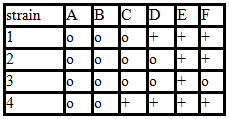The processes of transcription and translation are collectively known as
A. gene duplication.
B. RNA processing.
C. protein synthesis.
D. gene expression.
E. DNA synthesis.
Answer: D
You might also like to view...
Which functional group is characteristic of organic acids such as acetic acid?
a. carbonyl group b. hydroxyl group c. phosphate group d. amino group e. carboxyl group
Noller’s conclusions from his experiments on ribosomes
a. were accepted immediately by the scientific community b. showed that the site of peptide bond formation is on rRNAs of the small ribosomal subunit c. indicated that site of peptide bond formation is on proteins of the small ribosomal subunit d. showed that the site of peptide bond formation is on rRNAs of the large ribosomal subunit e. indicated that site of peptide bond formation is on proteins of the large ribosomal subunit
Which biochemical pathway fits the data presented?
Assume that a series of compounds has been discovered in Neurospora. Compounds A–F appear to be intermediates in a biochemical pathway. Conversion of one intermediate to the next is controlled by enzymes that are encoded by genes. Several mutations in these genes have been identified and Neurospora strains 1–4 each contain a single mutation. Strains 1-4 are grown on minimal media supplemented with one of the compounds A-F. The ability of each strain to grow when supplemented with different compounds is shown in the table (+ = growth; o = no growth).
media supplement

A) A ? B ? C ? D ? E ? F
B) A ? B ? C ? F ? D ? E
C) F ? B ? C ? D ? A ? E
D) A ? B ? C ? D ? F ? E
E) A ? B ? F ? E ? C ? D
"I wish my Dad would stop smoking! Doesn't he know that nicotine inhibits the _________ lining his trachea, and when they stop moving, bacteria and viruses can settle down into his lungs causing pneumonia and emphysema?"
A. cellular respiration B. mitochondria C. cilia D. lysosomes